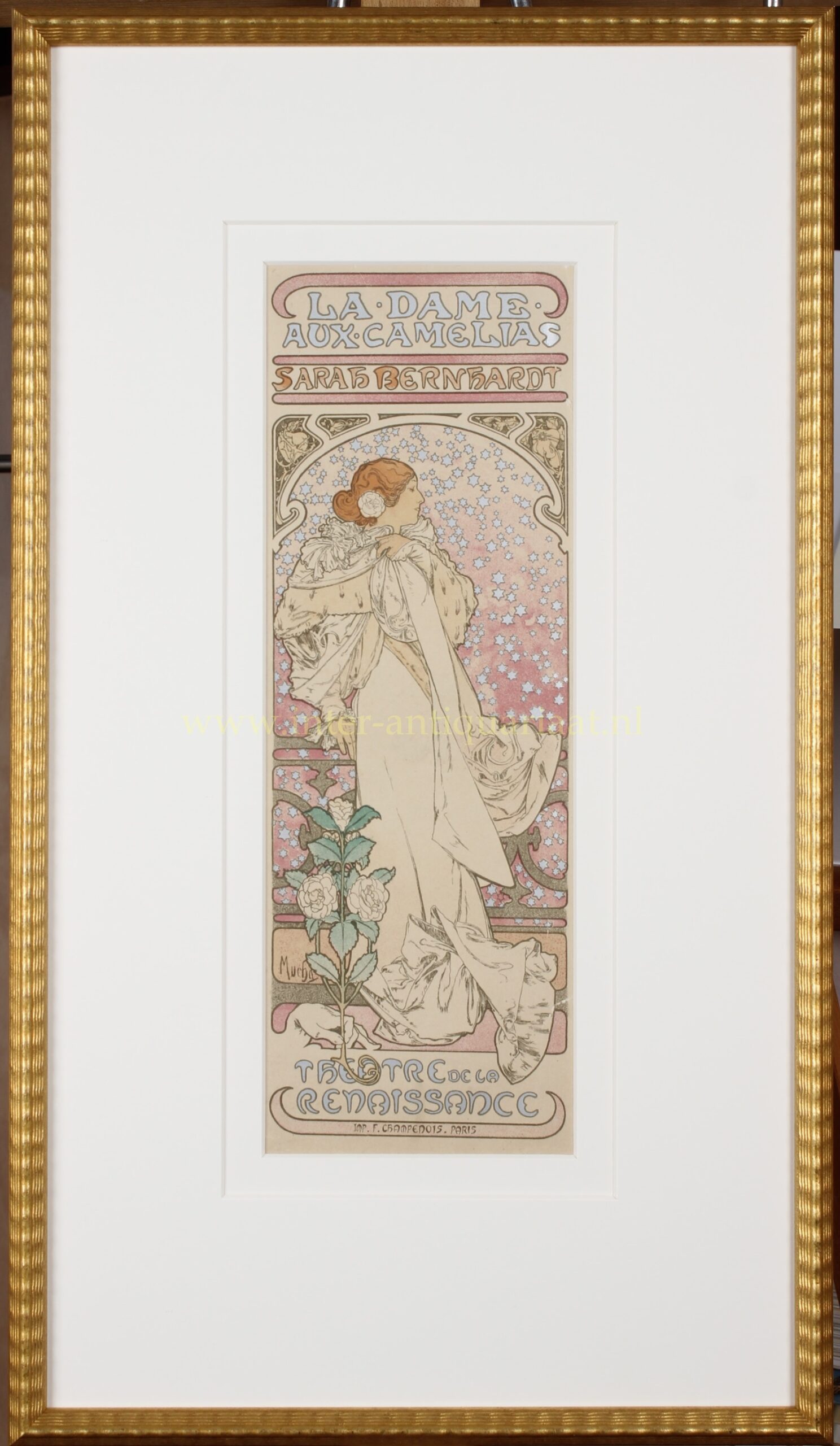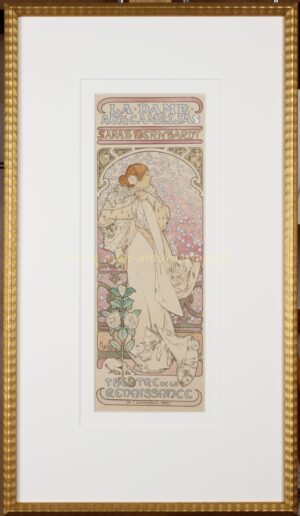“La Dame aux Camélias” lithograph in colours designed by Alphonse Mucha (1860-1936), here in an edition of 1896-1898 from “Les Maîtres de l’Affiche” printed by Imprimerie Chaix. Signed in the print in the lower left. Size.: (print) 32,5 x 10,5 cm (frame: 53,5 x 31 cm.)
Alphonse Mucha was born in Moravia (now Czech Republic) and is inseparably associated with Art Nouveau, initially called ‘le style Mucha‘. Like no other, he knew how to depict the Slavic soul with a light melancholic touch. In 1887, Mucha moved to Paris. The entire city was overwhelmed by his work, and the posters were even stolen from the streets. The graceful lines, fresh pastel colours, and lavish motifs in his illustrations of sensual women became the icons of the fin de siècle.
Mucha’s style is beautifully expressed in the large posters he designed in the 1890s, which made him famous and internationally recognized. The most important of these are the posters for the Parisian actress Sarah Bernhardt. What made this work revolutionary from an artistic standpoint was the refinement he brought to what had until then been an extremely colourful, often even garish, Parisian street decor. Thanks to Mucha’s contribution, the poster acquired a new meaning in modern art.
Mucha succeeded in giving the posters for Sarah Bernhardt a great dramatic power. His intuitive sense of what is visually effective is evident in all his creations.
Sarah Bernhardt played the lead role in Alexandre Dumas‘ La Dame aux Camélias more than once. Mucha’s poster was intended for the 1896 revival. This magnificent work presents a dramatic image of the tragic love of the courtesan Camille, who, dying of tuberculosis, releases her lover from his pledge of fidelity. The weakened heroine leans against the balustrade against a backdrop of silver stars. White camellias, her favourite flower, are abundant. She has one in her hair, and the other, in the hand of fate at the bottom left, symbolizes death. The smooth stem of the plant contrasts with the thorny roses that encircle the hearts in the frame above the figure and refer to the main theme of the play: the ultimate sacrifice of love.
The Maitres de l’Affiche series was the direct result of international interest in posters and poster artists that reached its height in the mid-1890s in Europe and America. The masterpieces of artists like Jules Chéret, Henri de Toulouse-Lautrec, and -as seen here- Alphonse Mucha, transformed commercial advertisements into an esteemed art form worthy of public adoration and scholarly pursuit. Along with the decade’s wave of poster journals, books, and exhibitions came a serious desire to collect the artworks for personal enjoyment and study — but the sheer size of posters made storage awkward and often times impossible.
The Maitres de l’Affiche (“Masters of the Poster”) series was born of this dilemma. By offering subscribers reductions of the era’s most important posters, collectors and enthusiasts were able to build miniature archives of posters from around the world. The complete Maitres de l’Affiche series boasted 256 expertly produced miniature lithographic plates representing the best of the Belle Époque. During its five-year run from late 1895 to 1900 the series was hugely successful, and it continues to be popular today, offering experts and novices alike a convenient and dazzling overview of some of the finest achievements in poster art.
It is not surprising that the exquisite Maitres de l’Affiche collection was the brainchild of Jules Chéret, inventor of the three-stone lithographic process and virtual founder of the modern poster. As early as the 1860s, Chéret’s magnificent creations brought elegance and colour to the urban landscape of Paris and soon generated an international industry. By 1866, Chéret opened his own print shop, which would eventually become a branch of the large French publisher Imprimerie Chaix. His role as artistic director at Chaix provided Chéret with the platform and resources necessary to launch the Maitres series.
The first four plates were released in December of 1895 and featured posters by Chéret, Toulouse-Lautrec, Julius Price, and Dudley Hardy. The series would continue for a total of 60 months, ending in November of 1900 — truly spanning the peak of the poster craze. In the end, there were a total of 240 regular plates and 16 bonus plates.
The Maitres de l’Affiche series operated much like a contemporary magazine. A poster enthusiast had the option of purchasing the current month’s four plates from a specialized dealer, or he could choose to subscribe to the series for the length of one year. In France, a one-year subscription cost 27,- francs, equivalent to roughly five to ten original full-sized versions of the posters highlighted in the Maitres series.
The original, full-sized posters and the Maitres prints they inspired were never considered in competition with one another; rather, they were viewed as two entirely different entities. While posters were large and bold, prints were beloved for their exquisite size and detail. In addition, posters were often printed on inexpensive newsprint due to their anticipated short lifespan.
Prints, on the other hand, were made on very fine paper using printing techniques too intricate for larger items. Print collecting was an extremely popular hobby in its own right well before posters became fashionable. Chéret introduced the modern poster, but it was not until Toulouse-Lautrec’s Moulin Rouge in 1891 that posters were elevated to an art form print collectors deemed worthy of their attention. In many ways, the Maitres series can be seen as the successful marriage of the poster and print crazes.
In his preface to Volume I of the Maitres series, Roger Marx, a notable 19th-century art historian and critic, described the streets of Paris as “a museum in the breeze.” He wrote that “the poster has a precarious fate… it gleams in sun, fades in the mist, dangles sadly in shreds, [and] sways in the wind after a heavy shower.” Although innately ephemeral in its purpose, the poster was saved by its beauty and charm. Les Maitres de l’Affiche, in its convenient format, has certainly stood the test of time.
Literature: Ann Bridges (ed.), “Alphonse Mucha the complete graphic works” (1980), L10
Price: Euro 2.150,- (incl. frame)





